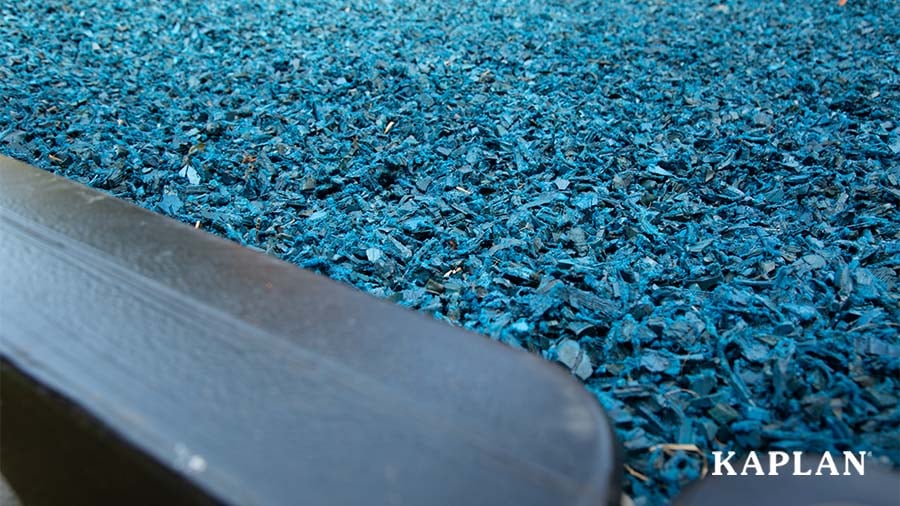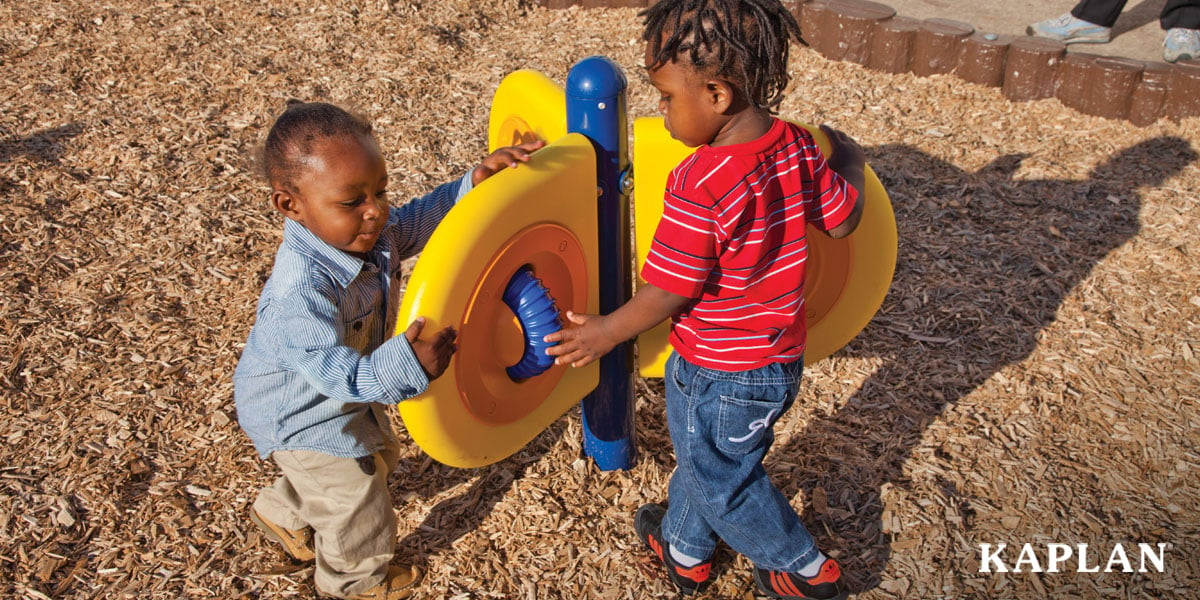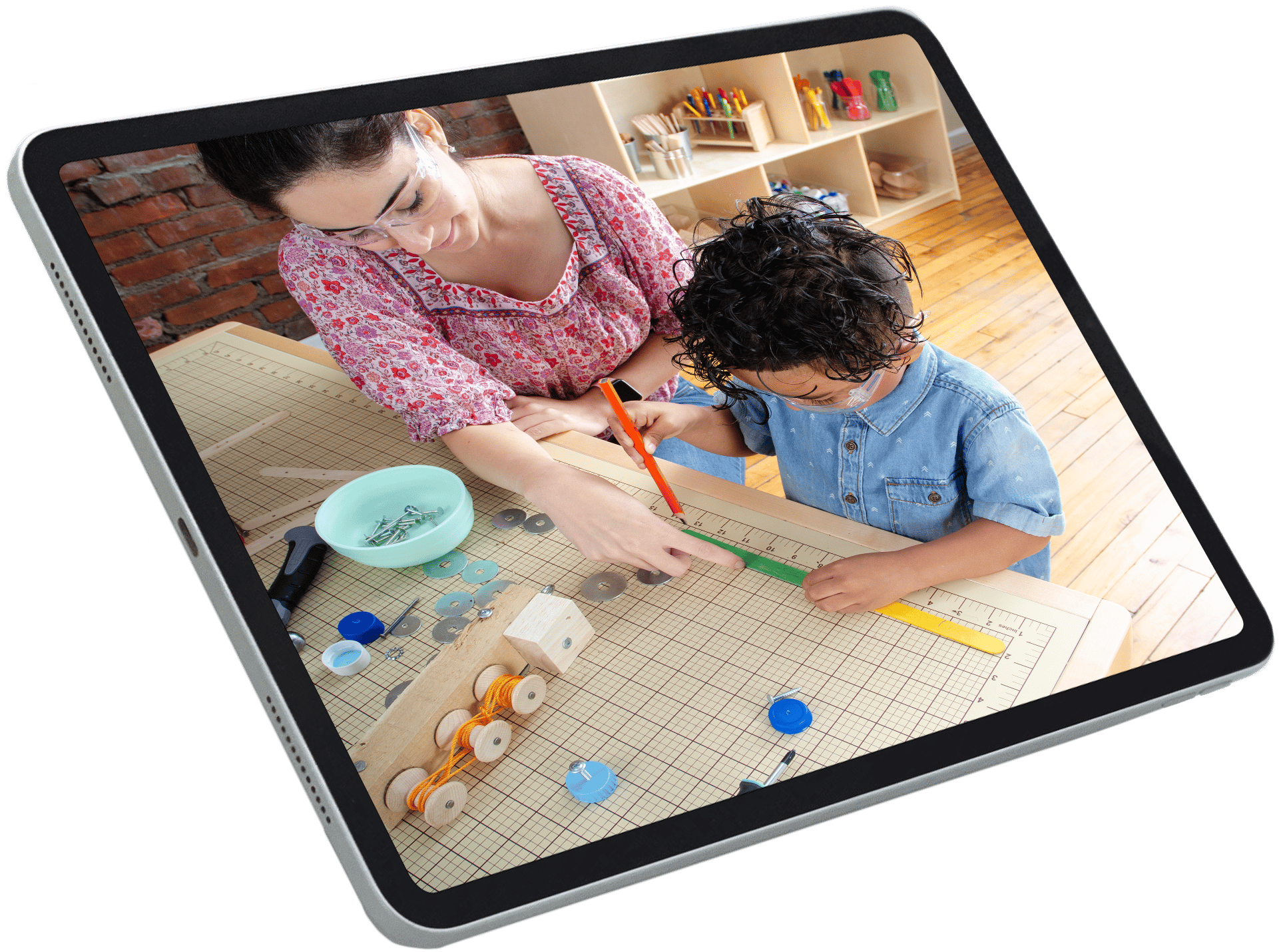Mulch surfacing is a popular choice for early childhood playgrounds due to its natural aesthetic, reasonable cost, and ability to cushion falls. However, this is not a “set it and forget it” solution. Without regular upkeep, mulch can shift, compact, decompose, and even wash away, compromising child safety, accessibility, and quality compliance.
This article will answer your top playground mulch maintenance questions so that you can keep your outdoor surfaces safe, clean, and compliant all year long.
What are the different types of mulch I could put on my playground?
The three most common types of playground mulch surfacing are wood, rubber, and engineered wood fiber. Often referred to as loose-fill surfacing, these materials cushion falls, particularly under playground equipment. While the three types of mulch function in the same way, they do have their differences.
Standard wood mulch
Standard wood mulch is made from various types of natural hardwood that are processed and shredded down to prevent splintering. Playground wood mulch does not have additives, chemicals, or other substances that could be harmful to children.
Engineered wood fiber mulch
While similar to standard wood mulch, engineered wood fiber mulch is made with processed wood fibers from sources such as construction-grade lumber. Engineered wood fiber is pre-consumer, which means that it has never been used for any other purpose. It is also explicitly designed to have fast drainage and high levels of shock absorption. Like standard wood mulch, engineered wood fiber does not have additives or chemicals.
Rubber mulch
Rubber mulch comes from recycled tires. To make rubber mulch, manufacturers thoroughly sanitize the rubber from the old tires and remove any steel fragments. Then, they shred the tires down into small, mulch-like pieces. If needed, they also apply nontoxic color to the mulch to give it a more natural feel.

How do I care for my playground mulch?
As we mentioned earlier, playground mulch requires regular maintenance to remain safe and effective. Whether you have standard wood mulch, engineered wood fiber, or rubber mulch, following these practices will ensure that your mulch lasts for years to come.
Weekly raking and leveling
As children drag their feet while swinging, land at the bottom of a slide , and run between structures, the mulch on your playground will become displaced and possibly compacted. Extreme weather, such as strong wind and heavy rain, can also displace mulch.
Over time, certain areas of the playground—especially high-traffic areas—will suffer from inadequate mulch depth and inadequate safety. According to the United States Consumer Product Safety Commission (CPSC), mulch must maintain a minimum depth (12 inches for wood mulch, 6 inches for rubber mulch) for 6 feet beyond all play structures to adequately protect children from falls.
The best way to maintain compliant mulch depths on your playground is to rake or “fluff” your mulch on a weekly basis. Use a sturdy garden rake to smooth out uneven areas of mulch and use a pitchfork to turn over areas that are compacted.
A good way to minimize mulch displacement in high-traffic areas such as under swings and beneath slides is to add Kick Out Mats on top of the mulch to prevent it from moving around while children are at play.
Monthly inspections
Monthly inspections are another key aspect of maintaining high-quality mulch surfacing. Going beyond surface-level cleaning, these inspections examine the playground’s structural and sanitary aspects to confirm that everything is in good working order. Conducting these inspections every month will ensure that major issues do not go unnoticed.
Depth checks
To keep your playground in compliance with state standards and guidelines, you will need to check the depth of your mulch in all areas of the playground on a monthly basis. Dig down to the mulch’s subsurface to ensure it meets the safety criteria. To make the process easier and faster, you can also make a mark on equipment supports or playground borders to give yourself a reference point for appropriate mulch depths.
Drainage checks
Proper drainage is essential for maintaining the quality and longevity of playground mulch. Standing water can lead to rapid decomposition, mold growth, and uneven surfaces, all of which create safety hazards for young children.
Check your playground for puddles at least once a month (it would also be good to do this after a particularly heavy rain). If your playground has a drainage system, inspect it regularly to make sure there is no buildup of debris such as leaves, mulch particles, or dirt.
Compacted mulch is also a major culprit of standing water. To prevent this problem from occurring on your playground, rake and fluff your mulch on a regular basis.
Pest control
Mulch—especially wood mulch—can become a home for unwanted pests such as ants, termites, yellow jackets, and mosquitoes. Be on the lookout for bees’ nests, anthills, or any other signs of these pests. If you encounter pests, spray them with a natural pesticide such as neem oil. Do not use a chemical pesticide because this could harm the mulch and may be unsafe for the children.
Cleaning and sanitizing as needed
Accidents will happen on your playground. Whether a child gets sick or has a bathroom accident, it is important to clean the affected area as quickly as possible so that germs do not spread. First, remove the soiled mulch from the playground. Then, clean and sanitize the affected area with a combination of water and white vinegar, waiting for it to dry before allowing play to resume.
How often do I need to replace playground mulch?
Although all of the practices listed above will give your mulch its longest possible lifespan, no mulch will live forever. Even if you’re diligent about caring for your mulch, you will still need to replace it every few years to keep it as clean, safe, and effective as possible.
Replace wood mulch every 1-3 years and replace rubber mulch every 10 years (or whenever you notice areas that do not meet compliant depths). Wood mulch needs to be replaced more often than rubber mulch because wood mulch is a natural material that decomposes and breaks down more quickly.
Want to know more about playground maintenance?
Whether you have standard wood mulch, engineered wood fiber, or rubber mulch, you are now equipped to properly maintain it and increase its longevity. Mulch, however, is not the only part of your playground that will require maintenance to last. Equipment, borders, and other playground materials will need care and upkeep as well. If you want to know how to maintain your other playground pieces, read this article. 

